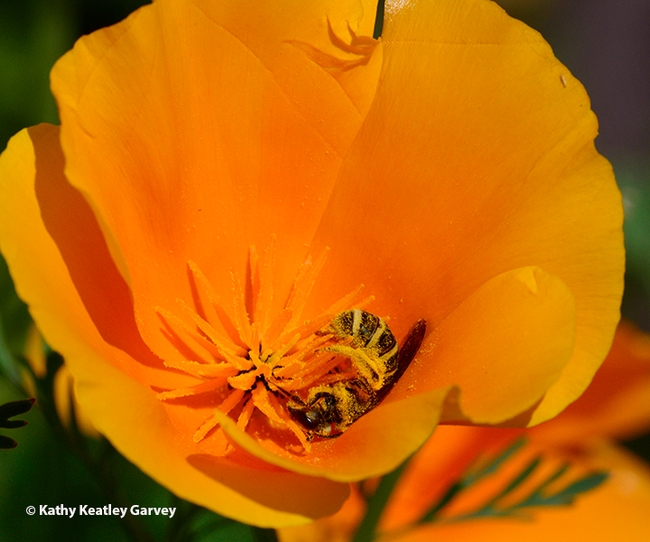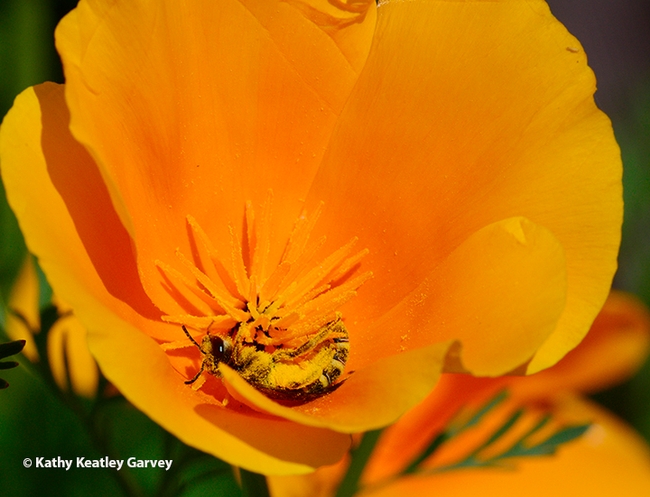- Author: Kathy Keatley Garvey
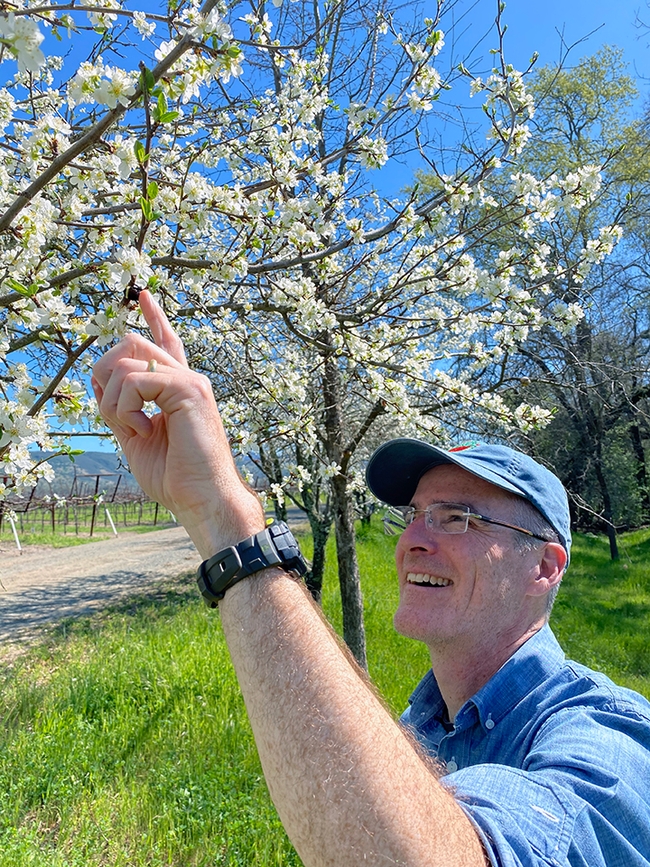
Its population is declining and he feared it might become extinct. B. occidentalis, sometimes called the "white-bottomed bee" due to its distinctive white markings on its abdomen, is known for pollinating blackberries, cherries, apples and blueberries.
Fast forward to today and the UC Davis research on how climate change is "rapidly restructuring North American bumble bee communities."
Newly published research from the laboratory of Professor Neal Williams, a pollination ecologist in the UC Davis Department of Entomology and Nematology (and close friend and colleague of Thorp), indicates a substantial shift in bumble bee communities.
The analytical paper, “Warming Summer Temperatures Are Rapidly Restructuring North American Bumble Bee Communities” --authored by ecologist Jeremy Hemberger, a former postdoctoral fellow in the Williams lab, and Professor Williams--appears in Ecology Letters.
“This is one of the first papers to show really substantial shifts in community composition in bumble bees due to climate, but also in insects more broadly,” said Hemberger, now a postdoctoral researcher at his alma mater, the University of Wisconsin, Madison. “We're also able to partition the effect we found to being driven by a loss of cold-adapted species, and a rapid rise in warm-adapted species across North America, but alarmingly we see that, above 50° parallel north, even warm-adapted species are declining.”
The 50th parallel north is a circle of latitude that is 50 degrees north of the Earth's equatorial plane. It crosses Europe, Asia, the Pacific Ocean, North America and the Atlantic Ocean. At this latitude, the sun is visible for 16 hours and 22 minutes during the summer solstice, and 8 hours, 4 minutes during the winter solstice, according to Wikipedia.
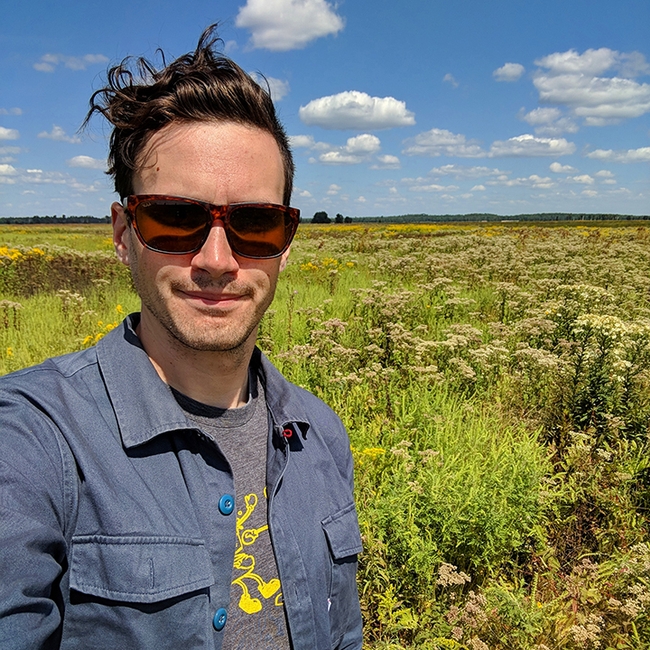
“Though additional confirmation is needed, our results suggest that northern bumble bee communities may be in crisis, with significant species turnover and declines in abundance that may threaten the persistence of populations in the coming decades,” they wrote.
“Overall, our work provides strong evidence of the pervasive impacts a warming planet has for insect biodiversity, particularly for historically cool-adapted species,” they related. “It also identifies regions of concern where anthropogenic climate warming is rapidly restructuring the communities of an ecologically important group of insects.”
They used along-term dataset of North American bumble bee species occurrences to determine whether the community temperature index (CTI), a measure of the balance of warm- and cool-adapted species in a community, has increased given warming temperatures. The database of 781,280 records from 1805 to 2020 was derived from a variety of sources, including natural history collections, research studies, and citizen science programs. To match the temporal range of available climate data, they used bumble bee records collected between 1960 and 2018.
“Over the last 29 years across the continent, bumble bee communities increasingly consist of fewer cool-adapted and more warm-adapted species with resultant increases in the community temperature index, a measure of the balance of warm- and cool-adapted species,” they wrote. “Changes are most pronounced at mid- to high latitudes and high elevations in the American Rockies, Intermountain West and central Mexico.”
Their project, launched in 2020 and completed in 2023, focused on 59 species. All California bumble bees were included in the analysis. The authors noted that the long-term, rising summer temperatures are “particularly alarming” to the Western bumble bee, Bombus occidentalis; the two-formed bumble bee, B. bifarius of Western North America; and the forest bumble bee, B. sylvicola, a high-altitude specialist native to North America and widely distributed in Canada.
B. occidentalis is one of the cool-adapted species that is declining. The yellow-faced bumble bee, B. vosnesenskii, native to the West Coast, is one of the "biggest winners” per the analysis.
Read the paper at https://onlinelibrary.wiley.com/doi/full/10.1111/ele.14492.
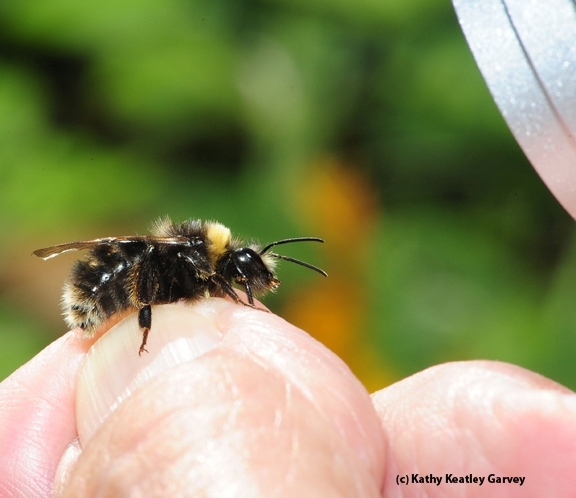
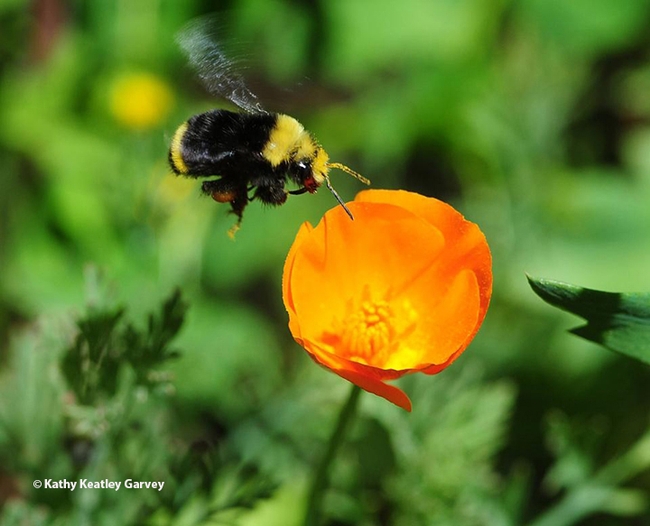
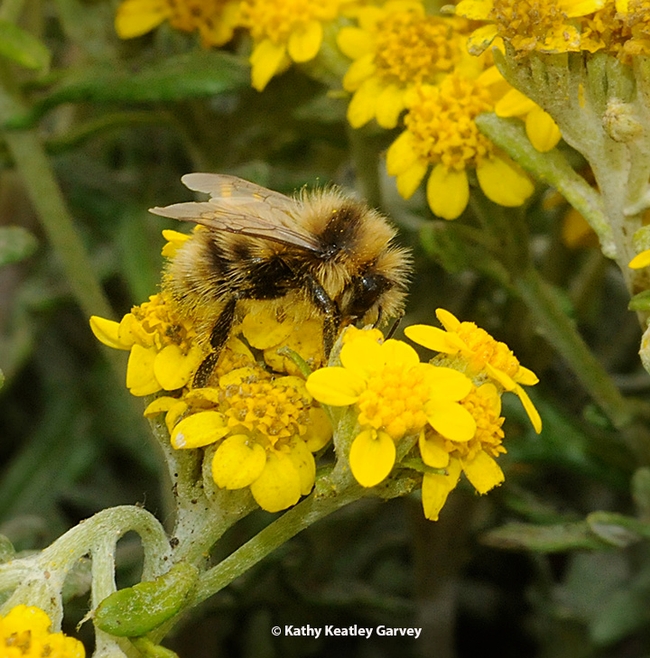
- Author: Kathy Keatley Garvey
Ever seen the male longhorned bees, Melissodes agilis, zipping around your garden, trying to bump all critters, large and small, off of "their" blossoms? They own them, ya' know.
These male bees are SO territorial. We've seen them target honey bees, bumble bees, carpenter bees, syrphid flies, spiders and praying mantises. And one another. Everything is fair game.
"They're saving the flowers for the females of their species, so they can mate with them," according to the late Robbin Thorp (1933-2019), UC Davis distinguished emeritus professor, Department of Entomology and Nematology.
But as dusk settles, there they are, the boys sleeping together in what Thorp called "The Boys' Night Out." The females return to their nests and the males "snuggle" together on lavender, sunflowers or whatever blossom suits them.
If you try to photograph them during the day when they're being territorial, you'll need to set your shutter speed at around 1/8000 of a second to freeze the action.
But if you try to photograph them at dawn or dusk when they're sleeping, it's so much easier. They begin to stir around dawn, as honey bees and bumble bees buzz by their sleeping quarters.
What's up, sleepy head?
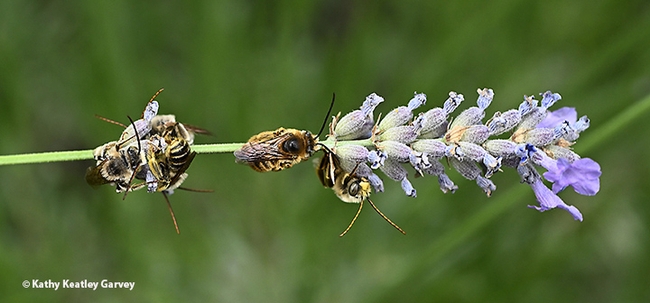
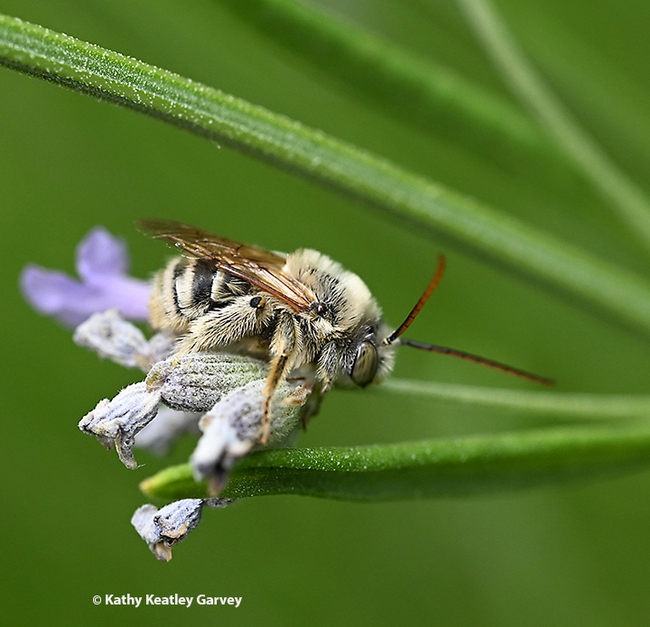
- Author: Kathy Keatley Garvey
We miss the late Robbin Thorp, 1933-2019, distinguished emeritus professor of entomology at UC Davis, who co-authored Bumble Bees of North America: an Identification Guide (Princeton University Press, 2014).
He loved to share his expertise on bumble bees, which originated more than 100 million years ago. But their distribution and diversity are not well known, he used to tell us.
Bumble bees are just one of the some 20,000 species of bees that populate the world. Of that number, however, only about 250 species are bumble bees, and they all belong to the genus Bombus.
Some 46 different species of bumble bees reside in North America, north of Mexico, Thorp related for a Bug Squad blog posted on July 10, 2014.
In their book, lead author Paul Williams and co-authors Thorp, Leif Richardson and Sheila Colla published information about bumble bees and their history, plant favorites, distribution maps, up-to-date taxonomy, and extensive keys to identify the many color patterns of the species.
They list sites to spot bumble bees:
- farms and gardens with a diversity of flowering crops and herbs
- hay fields
- roadside ditches
- windbreaks with good abundance and diversity of “weedy” flowering plants, such as clovers and vetches
- wetlands and wet meadows
- hardwood forests
- mountain meadows, and
- urban parks and gardens
The primary species found in Yolo County, Thorp related, are:
- Yellow-faced bumble bee, now known as the Vosnesensky bumble bee, Bombus vosnesenskii
- Yellow bumble bee, Bombus californicus, now known as Bombus fervidus
- Black-tailed bumble bee, Bombus melanopygus, formerly known as Bombus edwardsii. This is the first to fly in the winter and spring.
- Crotch bumble bee, Bombus crotchii, a short-tongued species
- Van Dyke bumble bee, Bombus vandykei, a medium long-tongued species
Lately we've been observing B. vosnesenskii, and B. fervidus, B. melanopygus in our pollinator garden in Vacaville, Solano County.
Currently, B. fervidus favors the rock purslane, Calandrina grandiflora. What a joy to see!
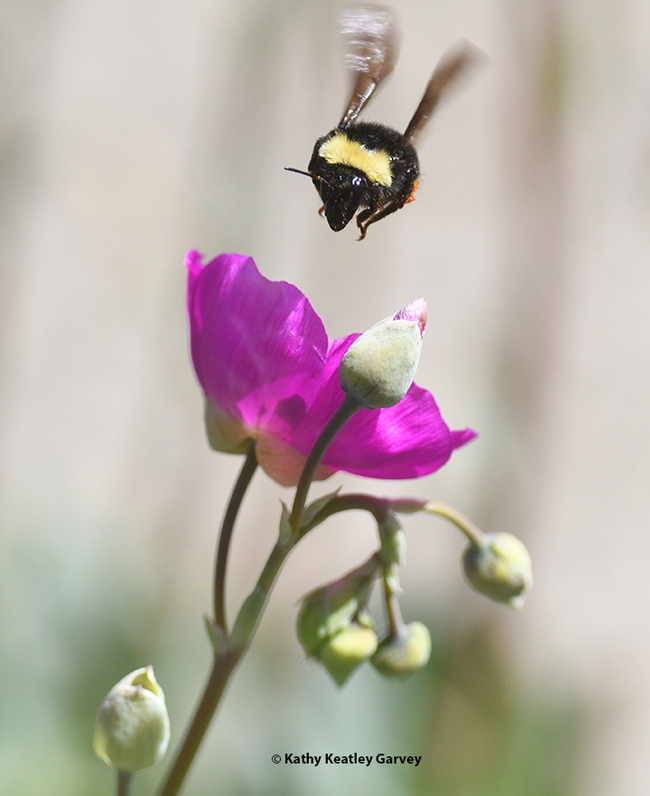
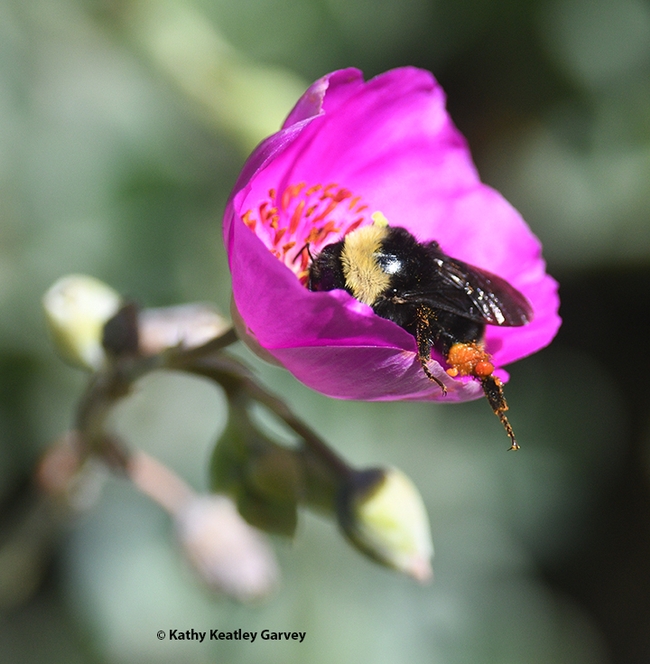
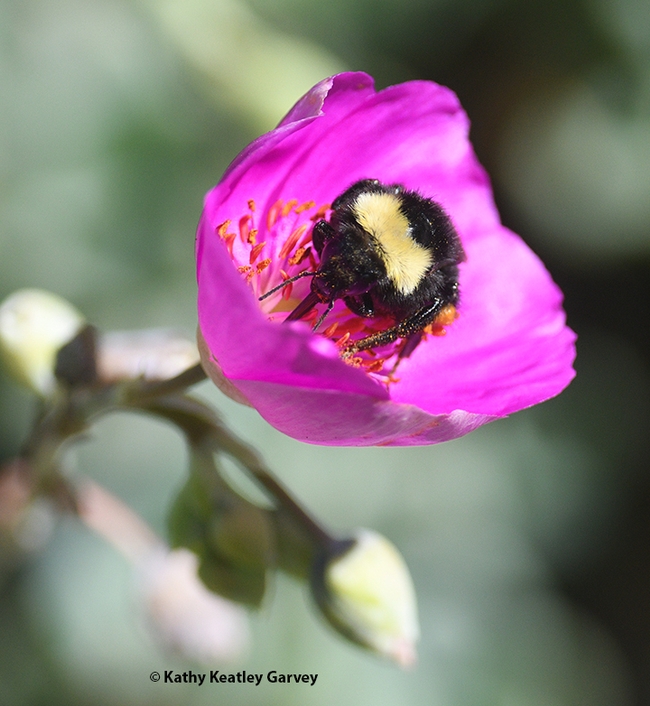
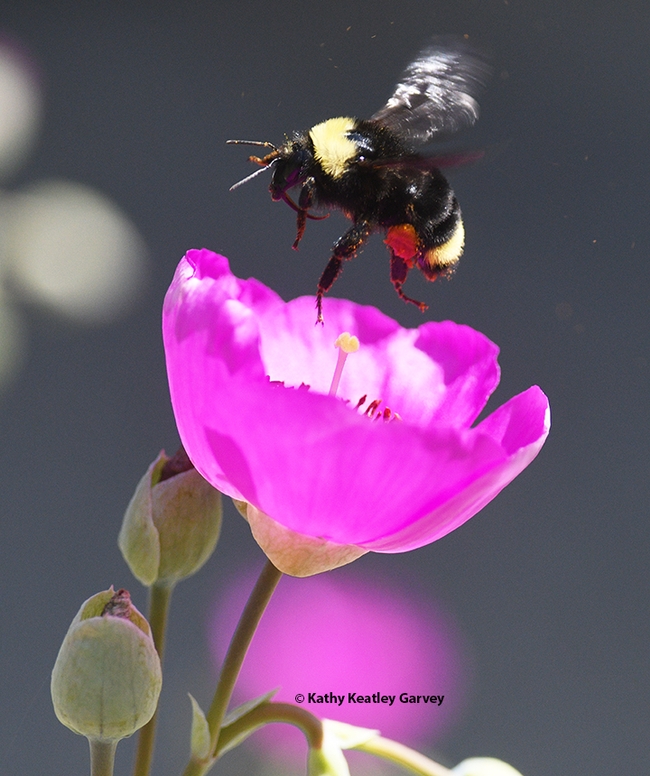
- Author: Kathy Keatley Garvey
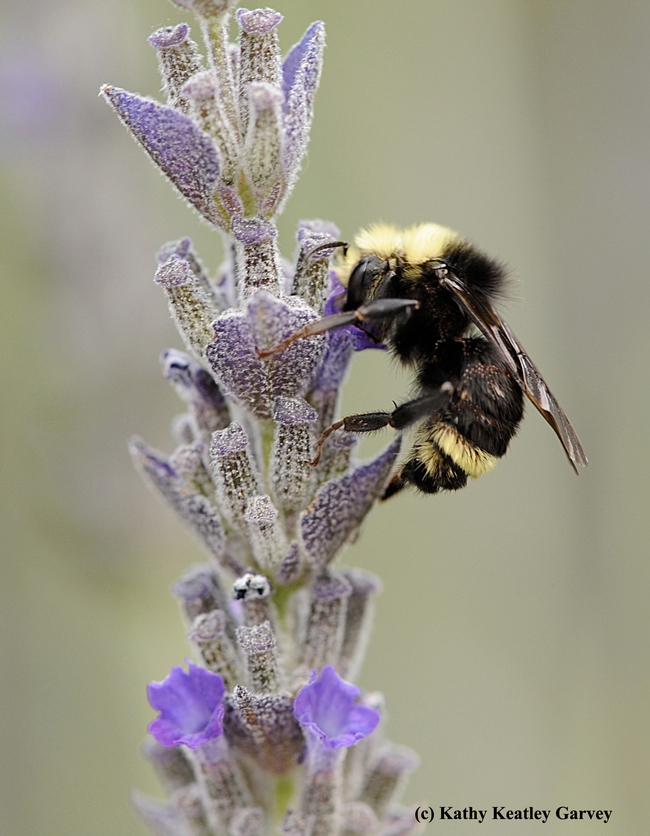
The United Nations designated May 20 as World Bee Day to raise awareness of the importance of pollinators, the threats they face and their contribution to sustainable development, according to its website.
It originated in 2018 when the government of Slovenia proposed that the United Nations declare May 20 as World Bee Day.
Why May 20? That was the day Anton Janša (1734-1773), a pioneer of modern apiculture, was born. "Janša came from a family of beekeepers in Slovenia, where beekeeping is an important agricultural activity with a long-standing tradition," relates Apimondia.
Today, however, let's pay tribute to the bumble bees. The late Robbin Thorp (1933-2019), UC Davis distinguished emeritus professor, UC Davis Department of Entomology and Nematology, used to point out there's only one bumble bee genus--Bombus--and that more than 250 species belong to this genus. California has 27 species of Bombus, according to Thorp in his 1983 published research, "Bumble Bees and Cuckoo Bumble Bees of California," written with colleagues Donald Horning Jr. and Lorry Dunning.
In his retirement, Thorp co-authored two books Bumble Bees of North America: An Identification Guide (Princeton University, 2014) and California Bees and Blooms: A Guide for Gardeners and Naturalists (Heyday, 2014).
Thorp, a member of the UC Davis entomology faculty for 30 years (1964-1994), continued his research, teaching and public service until his death in 2019 at age 85.
Franklin's bumble bee, Bombus franklini--a bee that he monitored for decades until his death in 2019--is now protected as an endangered species under the Endangered Species Act (ESA). It is feared extinct. Thorp, the last known person to see Franklin's bumble bee in its native habitat, spotted it in 2006 near Mt. Ashland. The bee inhabits--or did--a 13,300-square-mile area confined to five counties--Siskiyou and Trinity counties in California; and Jackson, Douglas and Josephine counties in Oregon. Its range may be the smallest range of any bumble bee species in North America, or even the world, he mused.
Today scientists are worried about the declining bumble bee population, a decline attributed to climate change, habitat loss, and pesticides. Bumble bees are especially known for their "buzz pollination" of such plants as tomatoes, peppers and cranberries. They help pollinate crops worth an estimated $3 billion in the United States alone.
"Due to threats including habitat loss, pesticide use and disease, sightings of the bee have declined by 89%, and it's disappeared completely from eight states. The decline of this once-common native bee is alarming and heartbreaking — and a harbinger of massive biodiversity loss across the country."--Center for Biological Diversity.
The dominant bumble bee species in California is the yellow-faced bumble bee, Bombus vosnesenskii. The Western bumble bee, B. occidentalis, used to be quite common. "It's one of four bumble bee species cleared by the state's Third Appellate District Court of Appeal for inclusion on California's endangered species list," according to a UC Riverside news story, published in July 2022.
Access the California Bumble Bee Atlas website to see how you can help. Meanwhile, how many species of bumble bees have you seen and photographed in California? Here are some of them.
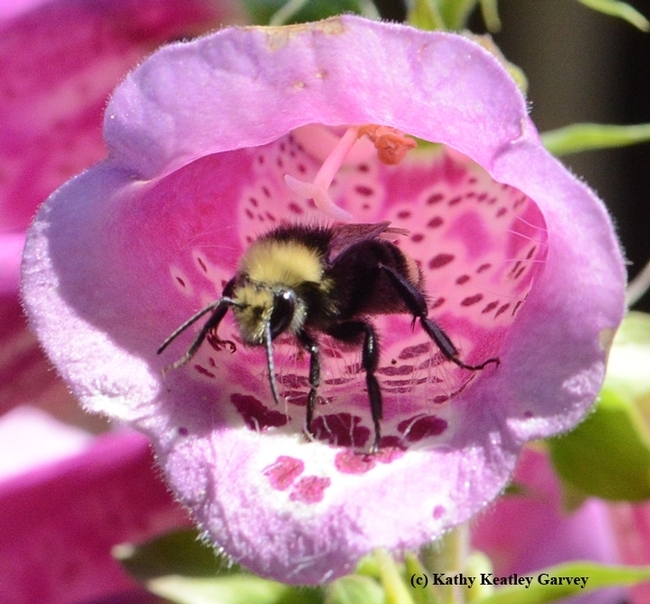
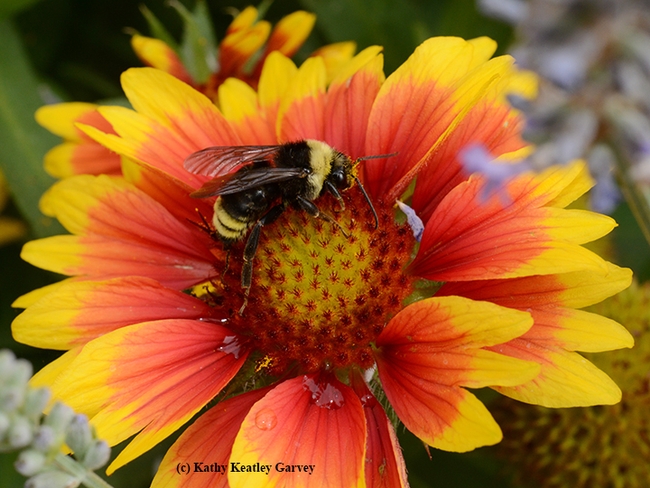
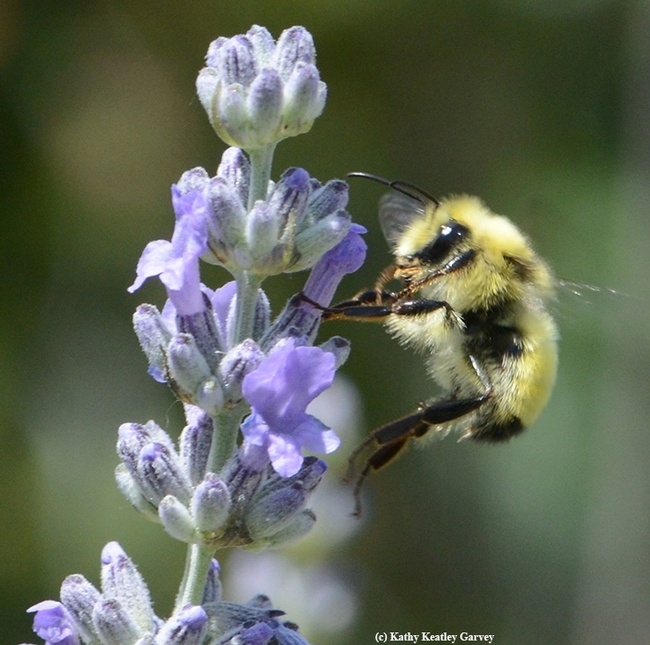
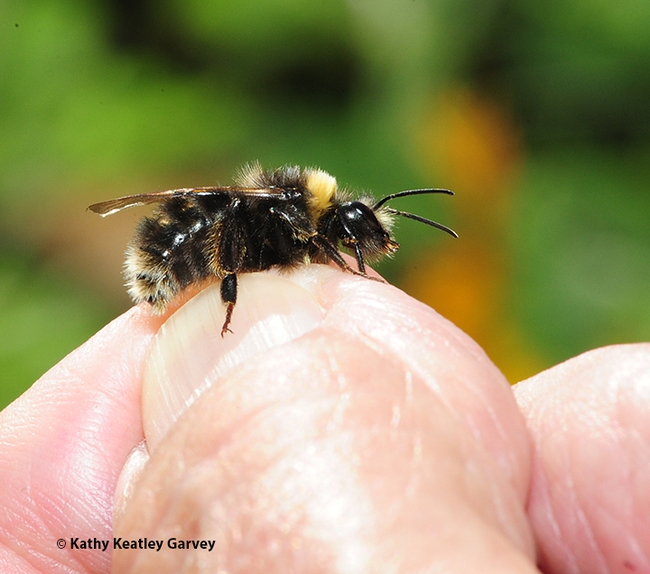
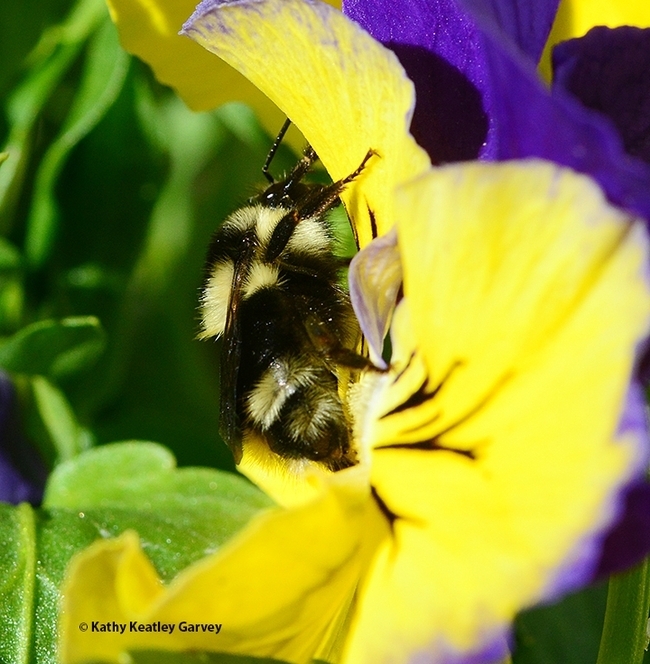
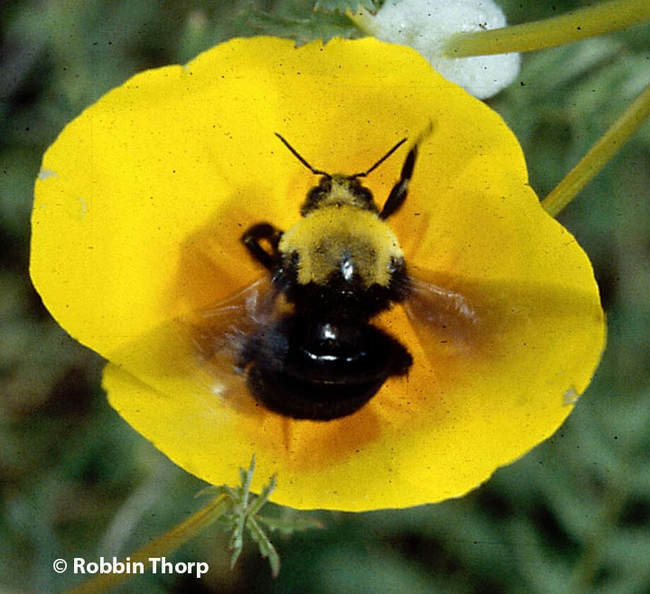
- Author: Kathy Keatley Garvey
Look closely at a patch of California golden poppies and you may see a sweat bee (genus Halictus) collecting gold pollen. The pollen basket is on the hind legs but you'll see "gold" also dusting the head and abdomen.
Native bee, commonly known as "halictid bee." Native plant. In fact, the California golden poppy, Eschscholzia californica, is the state flower.
And the rumor that it's "protected" and you'll get arrested if you pick a poppy along a roadside is inaccurate.
The California Department of Fish and Wildlife sets the record straight on its website: "It is often believed that there are laws prohibiting the cutting or damaging of the California poppy because it is the state flower. While there is no law protecting the California poppy specifically, California Penal Code Section 384a(opens in new tab) requires written landowner permission to remove and sell plant material from land that a person does not own, and removing or damaging plants from property that a person does not own without permission may constitute trespass and/or petty theft. However, these laws do not prevent the collection of California poppies on private land by the landowner. California poppies are a beautiful and easy-to-grow addition to your garden, and although you may choose to pick them from your property, they last much longer in the ground!"
Want to learn more about native bees? California has some 1600 species of wild or non-managed bees. Be sure to read California Bees & Blooms: A Guide for Gardeners and Naturalists. It's the work of University of California authors, all with UC Berkeley connections: Gordon Frankie, now professor emeritus, UC Berkeley; Robbin Thorp (1933-2019), UC Davis distinguished emeritus professor who received his doctorate in entomology from UC Berkeley; photographer Rollin Coville, who holds a doctorate in entomology from UC Berkeley, and Barbara Ertter, curator at the UC Berkeley-based University Herbarium and Jepson Herbarium.
The Bohart Museum of Entomology is hosting an open house on bees, both wild and managed, from 1 to 4 p.m., Sunday, May 19 in Room 1124, Academic Surge Building, 455 Crocker Lane. It's free and family free.
